Sharks are sharks, right? Not so fast, young Cousteau. There are over 500 species of sharks, and the Mako Shark is one of the more well-known. And this may not help your dream life, but they’re also the fastest sharks in the world.
If being afraid of sharks increases your respect for them, then you’re on the right track. But if it stops you from learning more about them, you’re missing out. Mako sharks do look menacing; however, they’re also beautiful, complicated creatures.
If not for movies like Jaws, we may think of sharks just as we do of jellyfish – interesting yet dangerous if you come close to them. We’re here to increase your curiosity about these marvelous fish and to help you understand them a little bit more.
So come along as we speed through the waters of the Mako shark. Just be sure to wear your wetsuit.
Top 10 Most Astounding Facts About Mako Shark
- Mako sharks range in tropical and temperate seas worldwide
- The largest mako adults can reach up to 4.5 meters
- Mako sharks can weigh over 500 kg
- At birth, the size of a baby mako shark is 70 cm in length
- A shortfin mako shark can bite with a force of up to 13,000
- They feed on herring, mackerel, swordfish, and small cetaceans
- The shortfin mako is the fastest shark on planet, reaching speeds of 46 mph
- Mako sharks have the ability to see in dark
- Mako sharks are apex predators
- Mako sharks have an average lifespan of 29 to 32 years
Scientific Classification of Mako Shark
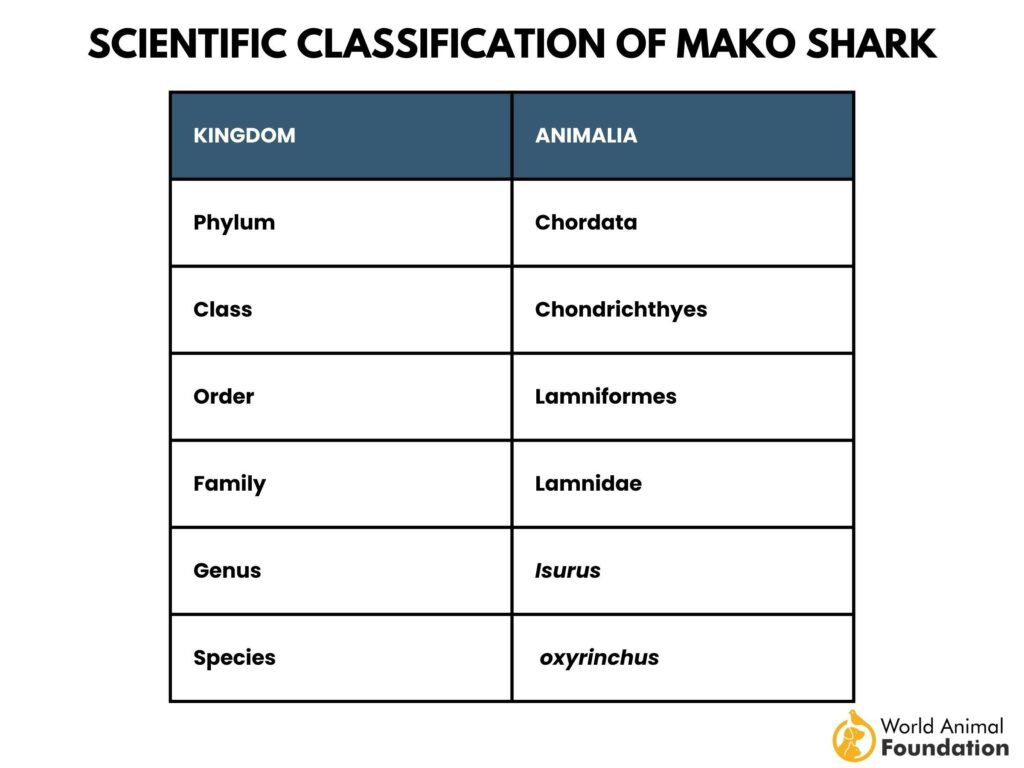
Mako Shark Facts

First, a shocking statistic – Since the 19th century, there has been a 99.9% reduction in the shark population worldwide. Fishermen are attracted to their fins (shark fin soup is called a delicacy) and meat. According to American Oceans, it is a traditional food in Iceland and Greenland, and mako is a favorite dish.
The insidious market is worth almost 1 billion dollars per year. Shark cartilage and oil are also used for profit. Did you know one hundred million sharks are killed yearly? That’s 100 million. It seems impossible. “Gluttonous” and “wrong” would be better adjectives to describe the slaughter.
Now. Let’s talk about those cetaceans we want to save. Mako sharks.
Mako Sharks Are Extremely Smart and Aggressive Hunters. (American Oceans)
Their agility, precision, and extremely impressive critical reasoning are almost unmatched in the ocean. They have the ability to burst through the water at high speeds when attacking prey. During these bursts, they’ll often bite the tails off first, disabling prey. They’re also known to hunt in packs. (source)
Mako Sharks Are Streamlined With Pointed Snouts, Crescent-Shaped Tails, and Slender Teeth. (American Oceans)
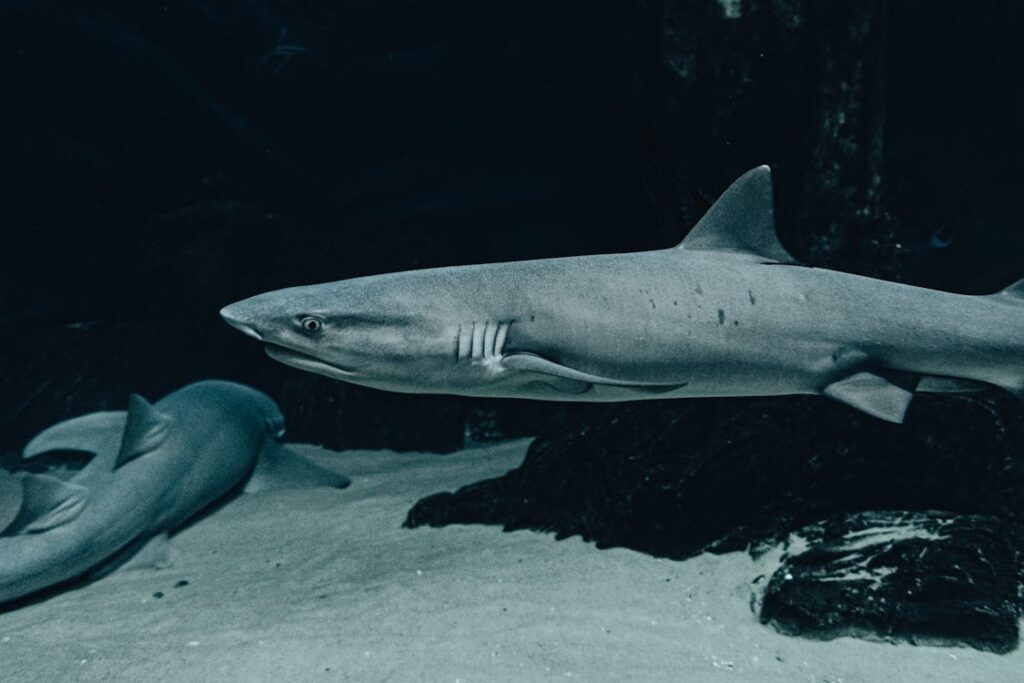
Mako shark teeth are designed to cut through flesh. Their teeth protrude forward from the jaw, making them visible when the mouth is closed. They have long gill slits, dark blue-gray back, and white undersides. The shark species has two dorsal fins, but one is much smaller than the other. (source)
A Shortfin Mako Shark Can Bite With a Force of Up to 13,000 Newtons. (Newsweek)
Bite strength is measured in psi-pound-force per square inch.
13,000 Newtons is equal to 2,922.52 lbs of force.
To put it in perspective, the strongest bite force ever recorded was from a saltwater crocodile at 3,700 lbs. And the average human has a bite strength of 162 pounds per square inch (psi). (source)
Mako Sharks Have the Ability To See in the Dark. (Bali Sharks)
The tapetum lucidum is a layer of reflective cells behind the retina of the eye that sharks have. This layer allows them to see better in the deep sea and at night. (source)
Mako Sharks Are Valued As Both Food and Game Fish, Celebrated for Their Strong Fights and Leaps. (NOAA.gov)
In fighting, they organize in numbers and try to incapacitate their prey as soon as possible, which may include decapitating them. Their leaps are what have gotten the attention of so many commercial and sport fishermen. (source)
Mako Sharks Are Known for Their Long Migrations Every Year. (Frontiers)
Although there’s still a lot to learn about a mako shark’s migration patterns, sea surface temperature seems to influence their migration. They move:
- Upward along the northeast coast of the US and Canadian Grand Banks in the summer and fall
- Move to the Sargasso Sea for the winter but spend little time there (source)
Scientists Have Observed Mako Sharks Swimming at Depths of Up to 2428 Feet. (Coastal Interpretive Service)

Ample amounts of prey are probably the reason why. According to a 2014 study, the twilight zone, the ocean area between 660 to 3,300 feet below the surface, has ten times more fish than shallower waters. (source)
The Shortfin Mako Shark Maintains a Higher Body Temperature Through a Countercurrent Exchanger. (NCBI)
According to the Florida Museum, it works by using the heat generated from active swimming muscles and the shark’s metabolism to warm its body’s core and major organs. This process makes heat retention possible. Makos are endothermic sharks. (source)
Shortfin Makos Are Apex Predators in the Pelagic Food Web. (Pelagic.org)
They are at the top of the food chain and are apex predators in their ecosystem. “Pelagic zone” is the open sea up to the surface, a column, other than near the coast or the ocean floor. (source)
Female Mako Sharks Rarely Reproduce. (Dutch Shark Society)
Shark pups in the womb feed on unfertilized eggs in the yolk sac and on each other (lesser-developed fetuses). This form of intrauterine cannibalism is known as embryophagy or adelphophagy – “eating one’s brother.” (source)
Shortfin Mako Sharks Engage in Internal Fertilization for Reproduction. (LSU)
Although the female mako shark gives live birth, shortfin makos don’t connect to their pups via a placenta. They then give birth to relatively large offspring. (source)
Mako Sharks Have an Average Lifespan of 29 to 32 Years, With Females Typically Outliving Males. (Animal Diversity)
Age is estimated using vertebral growth bands since one is produced per year. They tend to die when caught in captivity. (source)
Mako Shark Size
The Largest Mako Adults Can Reach Up to 4.5 Meters. (14.8 Feet) in Length. (Medium)
Their average length is from 3.2 m (10+ feet) to 3.8 m (12+ feet). Adult weight ranges between 60 to 135 kg (females may reach 150 kg). (source)
Mako Sharks Can Weigh Over 500 kg (About 1,100 Pounds). (American Oceans)
This is the weight of the longfin mako shark, and it’s one of the largest members of the Mackerel Shark family. The slimmer build and broad pectoral fins of the longfin appear to make it a slower and less active swimmer than the shortfin mako. (source)
The Second-Largest Shark in the Lamnidae Family Is the Longfin Mako Shark. (EDGE)
Only the great white shark is larger. The longfin mako seems to be more of a mystery for researchers than the shortfin. (source)
Where Do Mako Sharks Live
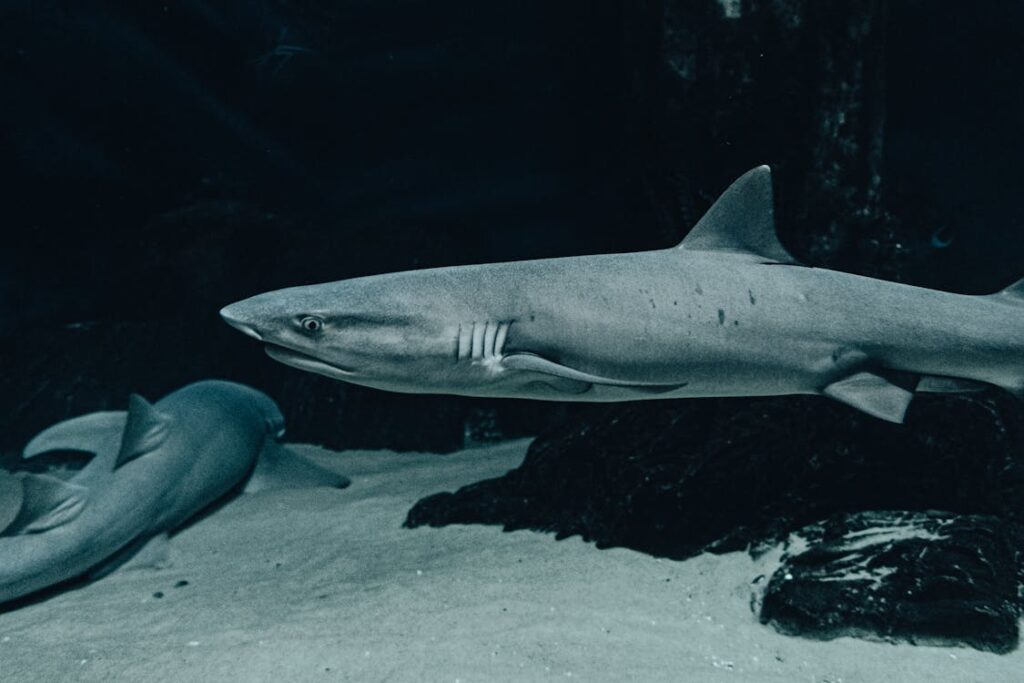
Mako Sharks Range in Tropical and Temperate Seas Worldwide. (Save Our Seas Foundation)
Makos have undergone tagging studies that have shown the species typically spends more time in deep, cold water during the daytime and then moves to shallow, warm waters at night. This is why it’s not the smartest idea to take an ocean dip during the evening in shallow waters. (source)
They Inhabit the Atlantic, Pacific, and Indian Oceans, Primarily Along the Equator. (Frontiers)
Since the mako crosses many jurisdictional boundaries, it’s difficult to investigate their habitat requirements and make sure they’re protected. It’s tough to manage fish! (source)
What Do Mako Sharks Eat
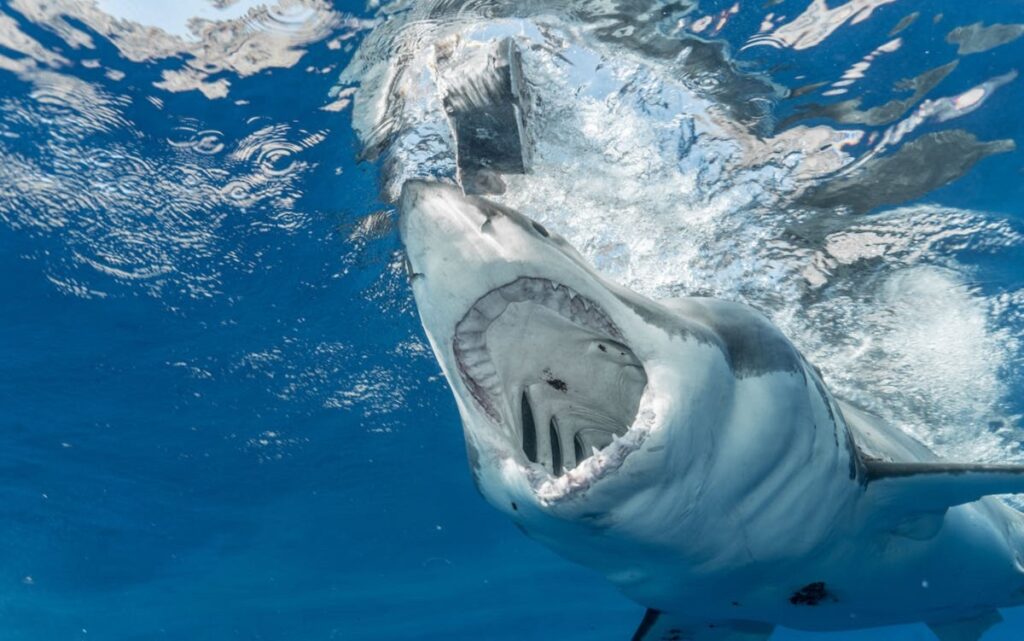
Mako Sharks Mainly Eat Bony Fishes, Squids and Also Prey on Other Sharks, Sea Turtles, and Organic Debris. (American Oceans)
Makos are generalist predators. The specific diet of the shortfin mako shark depends on:
- Life stage
- Geographic location
- Season
- Oceanic habitat
They Also Feed on Herring, Mackerel, Swordfish, and Small Cetaceans. (American Oceans)
The mako shark’s diet is likely strongly correlated with prey availability. It is consumed as it’s encountered. Mako sharks are opportunistic predators.
Baby Mako Shark
Mako Sharks Have a Small Number of Large Offspring. (Animal Diversity)
Makos give birth to 4-16 pups, and juveniles grow quickly initially. There is some evidence that females return to birthing and nursery sites repeatedly.
At Birth, the Size of a Baby Mako Shark Is 70 cm in Length. (Florida Museum)
This is a little over two feet long. Males reach maturity between 7-9 years old, and females after 18 years of age. (source)
During Gestation, Mako Shark Mothers Provide Unfertilized Eggs for Their Young’s Nourishment. (American Oceans)
Although there is little known about the mako’s mating habits, mating is thought to take place in late summer and early fall. The mating courtship seems to be violent since males bite females’ gill regions, pectoral fins, bellies, and flanks.
Mako Shark Speed
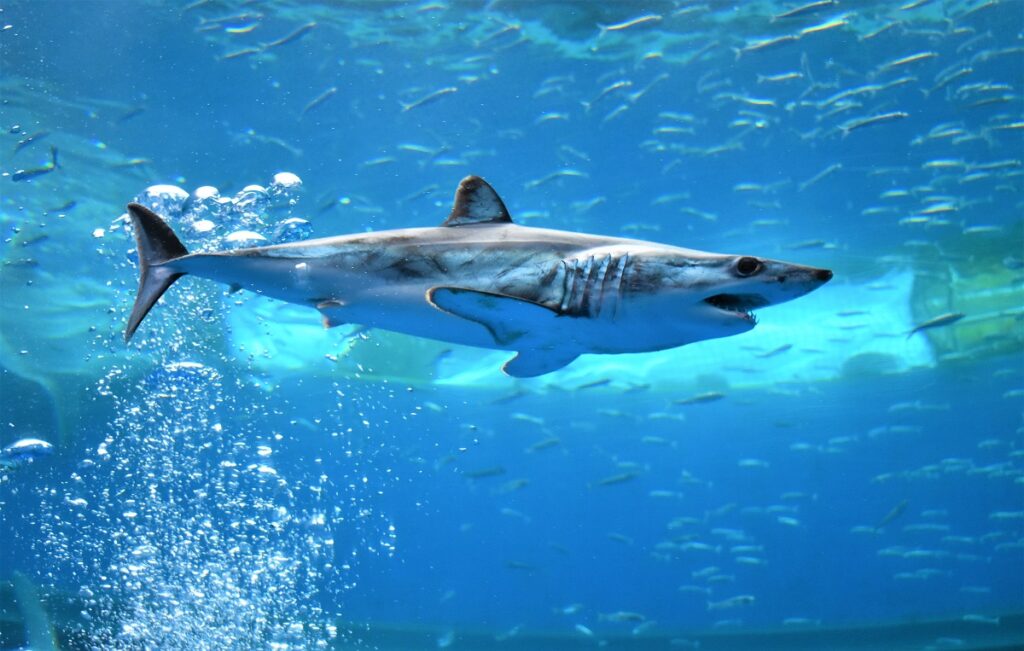
The Shortfin Mako Is Popular for Its Exceptional Leaping While Hunting. (Blue Ocean Dive Centers)
The shortfin mako’s body is torpedo-shaped, sleek, and streamlined. According to Blue Ocean, it’s perfectly adapted for speed and agility in the open ocean. (source)
The Shortfin Mako Is the Fastest Shark on the Planet, Reaching Speeds of 46 Mph. (Smithsonian Oceans)
Its moving speed is 31 mph with bursts of speed up to 46 mph+ (Marine Bio). Reminder: This is through the water(!), and faster speeds are usually demonstrated while hunting.
Mako Conservation Status
The Overfishing of Sharks Is Driven by International Trade That Goes Way Beyond Their Fins. (Greenpeace)
Regrettably, their meat is commercially sold, distinguishing them as one of the few shark species subjected to this practice. Whether it be commercial fishing, fishing for sport, or regular trawling, sharks are being scooped up like sand in a bucket. (source)
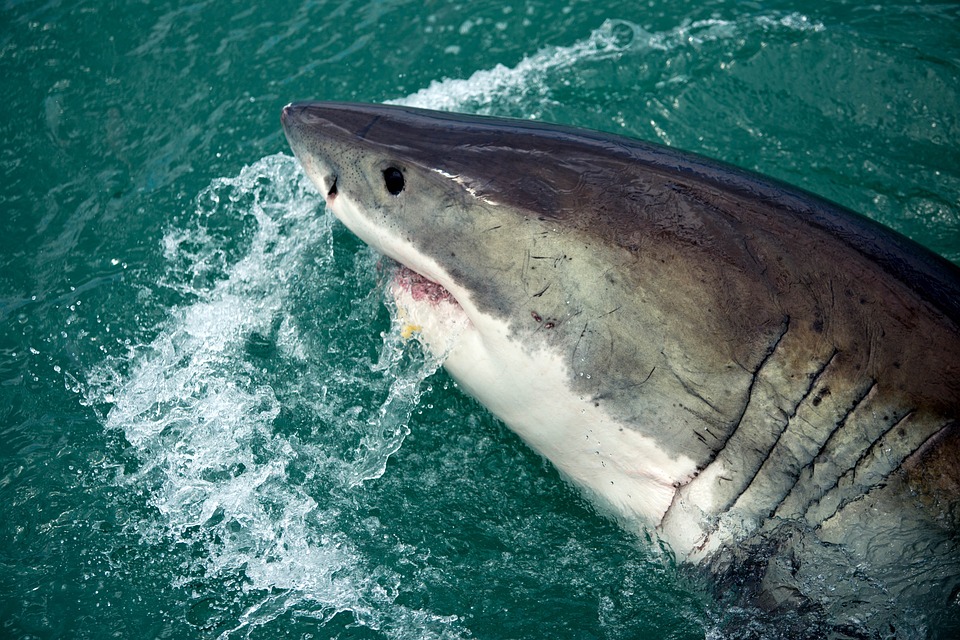
Today, there’s good news and bad news. The bad news is that we’re still losing too many sharks. Both shortfin and longfin mako sharks are on the endangered list of the International Union for Conservation of Nature (IUCN), and their numbers are decreasing. The good news is there are laws in place to protect them.
- The Shark Finning Prohibition Act of 2000
- The Shark Conservation Act of 2010
- Several states have shark fin laws tougher than some of the requirements contained in the Shark Conservation Act of 2010.
- There are sustainably managed shark fisheries that eliminate the horrific practice of finning.
- Two species of mako shark can no longer be traded unless it can be proven that their fishing will not impact their possibility of survival.
- International traders are (supposed to be) held accountable for sustainable practices.
- Critical catch limits are in effect worldwide. (source)
Due to the gouging of our shark populations, we have places/activists like Save Our Seas Shark Research Center (SOSF-SRC). The center focuses mainly on scientific research aimed at increasing knowledge to aid the conservation, management, and understanding of sharks and rays worldwide.
Fun Facts About Mako Sharks
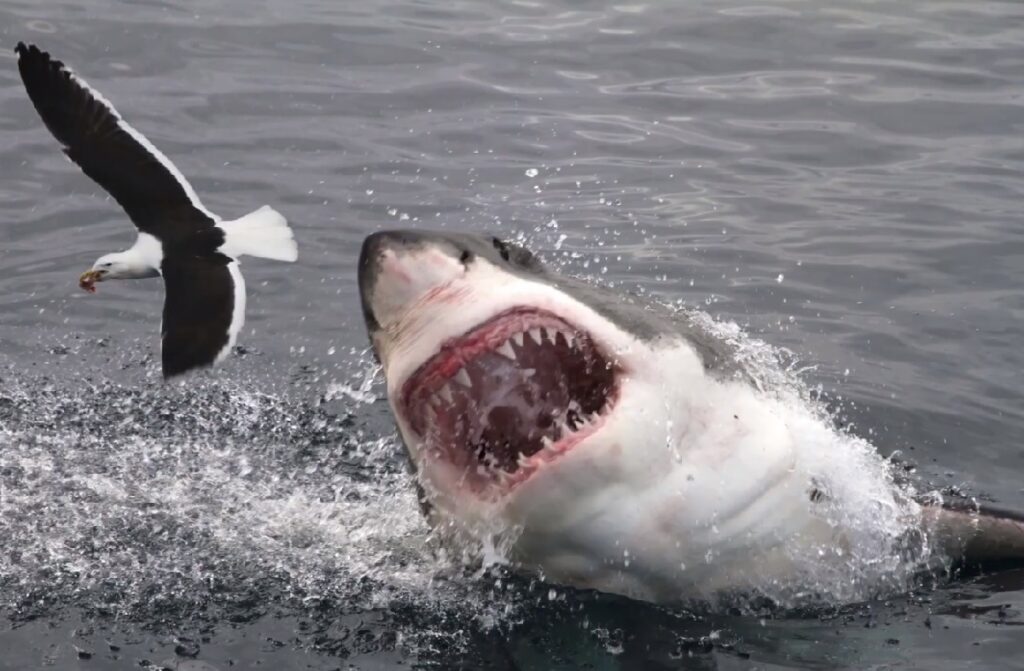
There Are Two Species of Mako Sharks. (Marinebio.org)
Two species of maco sharks exist: Shortfin and longfin. Shortfins are more commonly found and are located in the Atlantic, Pacific, and Indian Oceans. Longfin makos are more rare and weren’t even considered a separate species until 1966. (source)
Their Coloration Provides Excellent Camouflage. (Marinebio.org)
Makos have deep purple/blue dorsal surfaces and white ventral (underbelly) surfaces. The shortfin mako is white around their mouth, and longfins have a shaded coloration in the same area.
Mako Sharks Can Jump Up to 20 Feet in the Air. (American Oceans)
Natural acrobats, these sharks will swim straight up under their prey and burst up and out of the water. As beautiful as it is, it’s unfortunately also a trait that attracts fishermen.
Mako Sharks Have the Same Family As Great White Sharks. (American Oceans)
Although macos are the top predators of their ecosystem, the Great White Shark and the Orca can and do overtake them. Their shared family is of the mackerel shark family, Lamnidae.
Mako Sharks Rarely Attack Humans. (American Oceans)
Between 1837 and 2019, there were 42 unprovoked shark attacks on humans. Three of these were fatal, which means makos were less than 1% responsible for shark-related fatalities. Although their sight is superior, some think human attacks are a case of mistaken identity.
Ernest Hemingway Included the Mako Shark in His Writings. (Spark Notes)
More specifically, they are included in The Old Man and The Sea. But Oceana thinks the author didn’t portray them well.
Researchers in Florida Are Employing Mako Sharks To Forecast Election Outcomes. (AJC)
In 2008, the Atlanta Journal-Constitution (AJC) reported that satellite tags that were attached to the dorsal fins of four sharks would determine how many miles they swam and who would win the gubernatorial election in Florida, USA. (source)
Mako Shark Facts for Kids
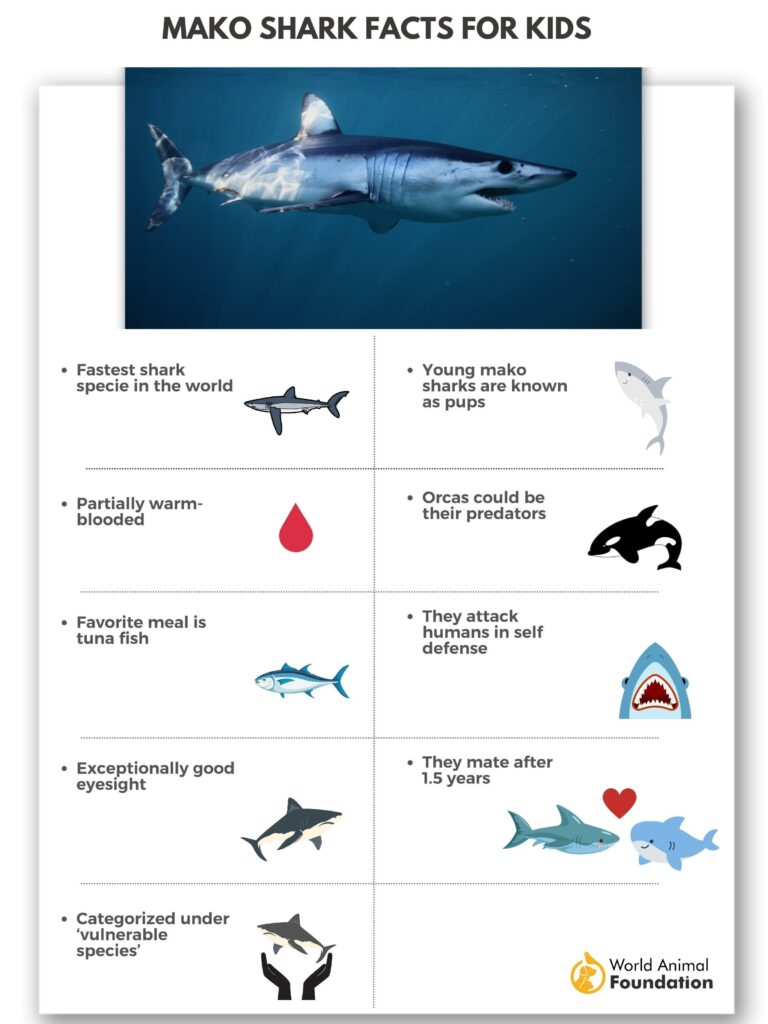
- These brilliant fish are the fastest sharks in the world.
- They have exceptionally good eyesight and hearing and are sensitive to low-frequency signals. Splashing could attract them since they listen for fish in distress.
- Great white sharks and Orca whales are two of their only predators, besides man who is their biggest enemy.
- Makos have extremely pointed snouts, grayish-blue bodies, and powerful tails.
- They also migrate to feed and mate and have been known to travel 1,300 miles in one month.
- Mako sharks are full of mystery, so it’s our job to get to know them as much as we can so we can make sure they’ll be around for a long time.
FAQs
Which Classification of Marine Organisms Includes Swordfish and Sharks?
Swordfish and sharks are classified as nekton.
Nekton animals are larger than microbes, strong swimmers, and move independently of water currents. (source)
How Fast Are Mako Sharks?
A mako shark’s moving speed is 31 mph with bursts of speed up to 46 mph+.
What Is Mako Shark’s Scientific Name?
Isurus oxyrinchus (Brittanica)
Conclusion
Whether you call them shortfins, blue pointers, mackerel sharks, bonitos, or palomas, it’s hard to deny that makos are one of the most magnificent fish in the deep blue sea.
So what can we do to help make sure they don’t become extinct?
Visit oceana.org where you can:
- Donate to support their work to protect the oceans.
- Support policy-changers and decision-makers who stand behind saving our seas.
- Symbolically adopt an animal.
- Help empower children to learn about and protect our oceans.
It’s not too late!
Makos are still on Earth.
They just need some help.
From me and you!


